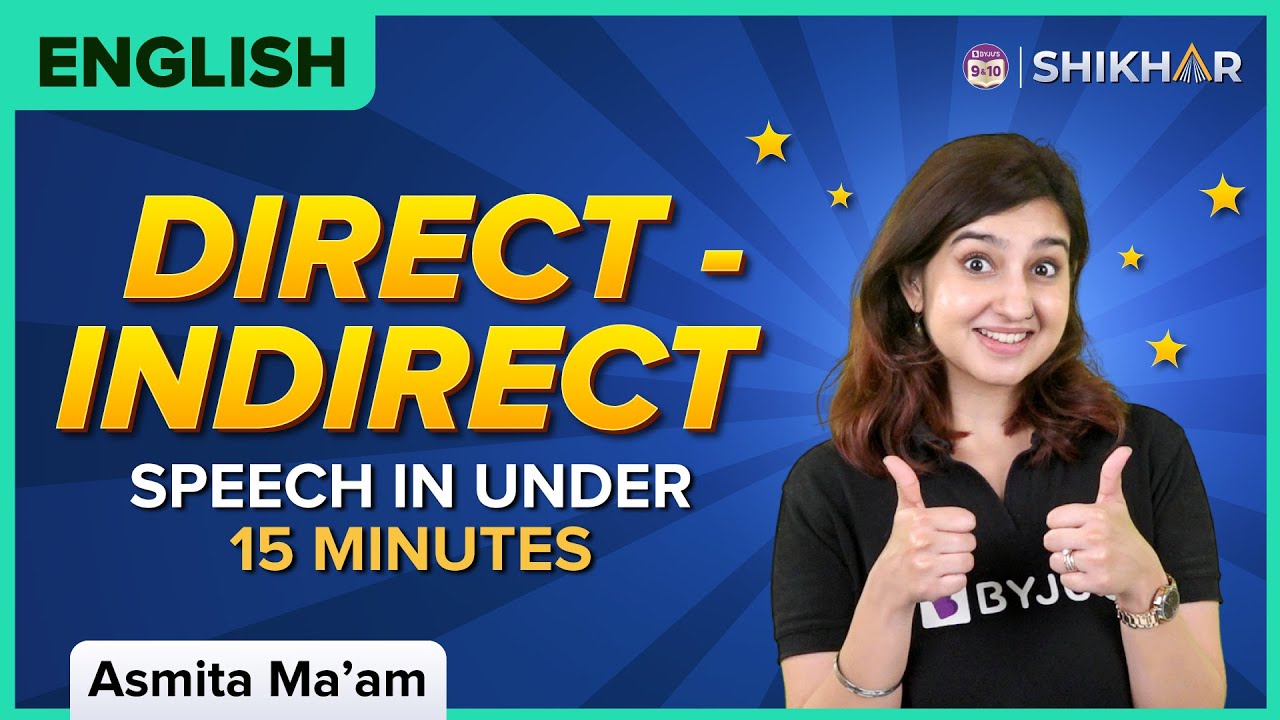KALIMAT LANGSUNG DAN KALIMAT TIDAK LANGSUNG || BAHASA INDONESIA KELAS 5 || KURIKULUM MERDEKA
Summary
TLDRThis video explains the difference between direct and indirect speech in writing. Direct speech involves quoting a speaker’s exact words, using quotation marks and proper punctuation. It starts with a capital letter and ends with a punctuation mark like a comma, question mark, or exclamation point. In contrast, indirect speech reports the speaker's words without quotation marks, often altering pronouns and using conjunctions such as 'that' or 'because'. The video highlights the key characteristics of both speech forms, providing examples to clarify their usage.
Takeaways
- 😀 Direct speech sentences are quoted using double quotation marks to represent exactly what the speaker says.
- 😀 The first characteristic of direct speech is that it begins with a capital letter at the start of the sentence.
- 😀 In direct speech, punctuation marks like commas, question marks, or exclamation marks are placed before the closing quotation marks.
- 😀 Direct speech sentences are separated from the narrative or tag line with a comma.
- 😀 Indirect speech sentences report what the speaker says in the form of a statement or news report.
- 😀 Indirect speech does not use quotation marks.
- 😀 In indirect speech, there are changes in pronouns and the form of the sentence.
- 😀 Common conjunctions used in indirect speech include 'that', 'because', 'so that', and 'about'.
- 😀 The transition from direct to indirect speech changes the verb tense and pronouns to match the reporting context.
- 😀 The script emphasizes understanding the differences between direct and indirect speech through examples and explanations.
Q & A
What are the two types of sentences mentioned in the transcript?
-The two types of sentences mentioned are direct speech (kalimat langsung) and indirect speech (kalimat tidak langsung).
What is the key feature of direct speech?
-Direct speech involves quoting the exact words spoken by the speaker, enclosed in quotation marks ('petik dua').
How should direct speech be punctuated in a sentence?
-Direct speech should begin and end with quotation marks, and the first letter of the sentence should be capitalized. Additionally, punctuation marks like commas, question marks, or exclamation points can appear before the closing quotation mark.
What are the characteristics of direct speech in terms of punctuation and capitalization?
-Direct speech starts with a capital letter and ends with appropriate punctuation (comma, question mark, or exclamation point). The quoted speech is enclosed in quotation marks, and the sentence may be followed by a dialogue tag separated by a comma.
What is indirect speech, and how does it differ from direct speech?
-Indirect speech reports what someone said but in the form of a statement rather than a direct quotation. Unlike direct speech, it does not use quotation marks and may involve changes in pronouns or other wording to fit the context.
What are the main features of indirect speech?
-Indirect speech does not use quotation marks, may involve changes in pronouns, and often uses conjunctions like 'that', 'so that', or 'because' to connect the clauses.
What conjunctions are commonly used in indirect speech?
-Conjunctions like 'that', 'so that', 'because', 'for', and others are used in indirect speech to link the reporting clause with the reported speech.
Why are changes in pronouns necessary in indirect speech?
-Changes in pronouns are necessary in indirect speech because the speaker’s point of view must be adjusted to fit the context of the reporting sentence. For example, 'I' might change to 'he' or 'she' in indirect speech.
What type of sentences use quotation marks according to the transcript?
-Sentences that quote someone's exact words (direct speech) use quotation marks to indicate the exact spoken content.
How does punctuation differ between direct and indirect speech?
-In direct speech, punctuation marks such as commas, question marks, or exclamation points are placed before the closing quotation mark, whereas in indirect speech, there are no quotation marks and the punctuation is part of the reporting sentence structure.
Outlines

This section is available to paid users only. Please upgrade to access this part.
Upgrade NowMindmap

This section is available to paid users only. Please upgrade to access this part.
Upgrade NowKeywords

This section is available to paid users only. Please upgrade to access this part.
Upgrade NowHighlights

This section is available to paid users only. Please upgrade to access this part.
Upgrade NowTranscripts

This section is available to paid users only. Please upgrade to access this part.
Upgrade NowBrowse More Related Video

6º ano - Língua Portuguesa – Vol 2 – Discurso direto e indireto

Direct - Indirect (Reported) Speech in Under 15 Minutes | Class 9 and 10 | English | BYJU'S

BAHASA INGGRIS SMA - Reported Speech (Indirect & Direct Speech) | GIA Academy

BELAJAR DIRECT AND INDIRECT SPEECH (REPORTED SPEECH)

REPORTED SPEECH - PENGGUNAAN DIRECT AND INDIRECT SPEECH - RUMUS DAN CONTOH

Reported Speech
5.0 / 5 (0 votes)